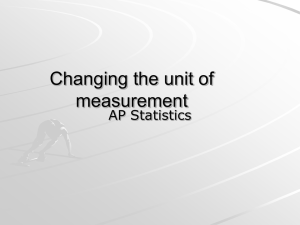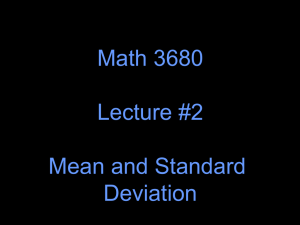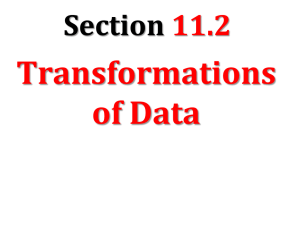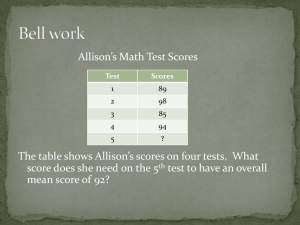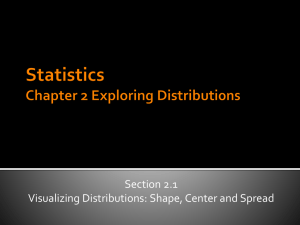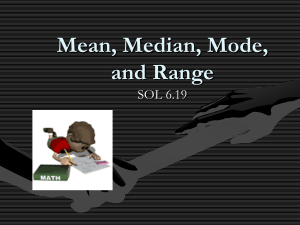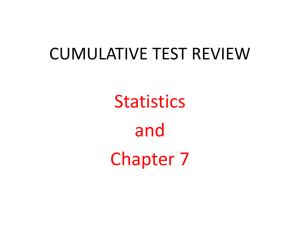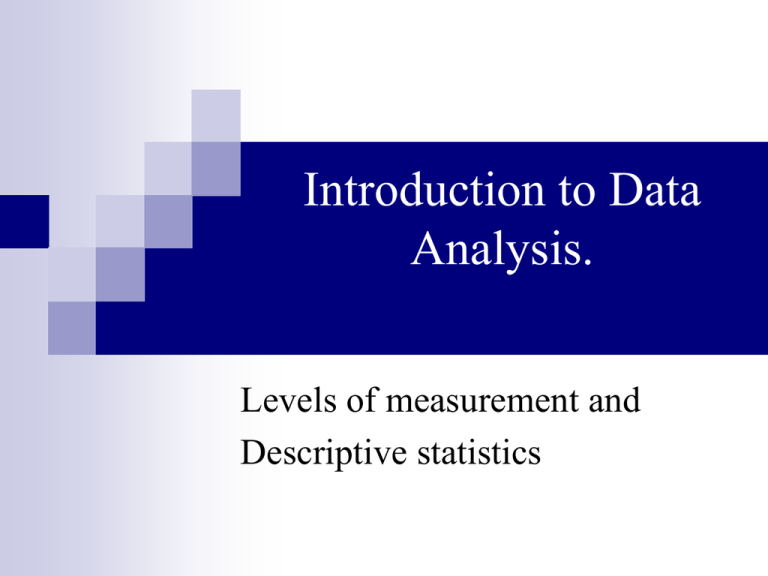
Introduction to Data
Analysis.
Levels of measurement and
Descriptive statistics
What’s this course about?
Introduction to the use of quantitative data in
social science.
The
tools we need in order to use numerical data
(i.e. anything we can count) to better understand
the world.
Very basic introduction, students intending to
write theses using primarily quantitative data
should also attend the intermediate/ advanced
lectures.
2
Why am I here?
Your own research.
Using quantitative data as an integral part of your thesis.
Using quantitative data as supplementary evidence.
Making better use of qualitative data.
Other people’s research.
Understanding work in your area.
Criticising work in your area.
It’s compulsory….
3
What is Statistics?
Methods for:
Designing
and carrying out research studies
Describing collected data
Making decisions/inferences about phenomena
represented by data
4
Some key terms (1)
Population—the total set of individual objects
of persons of interest in a study
Sample—a subset of the population that is
actually observed
5
Key Terms (2)
Descriptive Stats consist of methods of
graphical and numerical techniques for
summarizing the information in a collection of
data
Inferential stats consist of procedures for
making generalizations about characteristics of
a population, based on info from a sample.
6
Key terms (3)
Parameters are the characteristics of the
population about which we make inferences
using sample data
Statistics are the corresponding characteristics
of the sample data, upon which we base our
inferences about parameters.
7
Some key terms (1)
Population—the total set of individual objects
of persons of interest in a study
Sample—a subset of the population that is
actually observed
8
Variables and their measurement
Variable = measurement of a characteristic of
a subject (something or someone) that varies
across subjects in a population of subjects.
Different levels of measurement, which means
that we have to examine different types of data
in different ways.
9
Some key terms (1)
Population—the total set of individual objects
of persons of interest in a study
Sample—a subset of the population that is
actually observed
10
Nominal level measures (1)
Just represent a category.
e.g. Male
Female.
e.g. Single
Married
Divorced.
Since there is no ordering, these are nominal
measures.
Often called qualitative, since two values
differ in quality not quantity.
11
Nominal level measures (2)
Can quantify these data
by tabulating them.
Normally represent
nominal data in a simple
table with percentages.
Take the marital status
of all of my 25 friends
(i.e. the population we
are looking at is “all
Ryan’s friends”).
Marital
status
Number
%
18
72%
Married
6
24%
Divorced
1
4%
25
100%
Single
Total
12
Ordinal level measures
Categories again, but these categories are ordered.
e.g. Many polling/survey questions.
“It was right for Britain to send troops to Iraq”
Strongly agree
Agree
Disagree
Strongly disagree.
The distance between each category is unknown.
“Strong agreers” are more hawkish than “agreers”, but we have no idea
how much more hawkish they are.
We can say on observation is greater in rank than another.
Can be ranking in class (for example) or from naturally ordered categories
Called quantitative because different values represent different
magnitudes.
13
Interval level measures
Numbers represent a quantitative variable.
We can not only say that my sister is younger than I
am, but that she is 2 years younger.
e.g. Income, number of pupils per teacher, age, etc.
There is a specific distance between each level.
Age is a continuous variable, one can also subdivide the measure
(784 days, 3 hours and 2 minutes younger…).
It is also true that my parents have only 2 children.
Number of children is a discrete variable, you cannot sub-divide
children, you have 1, or 2, or 3. You can’t have 2 ½ children.
14
Descriptive statistics
Most statistics that we will cover today apply
to variables that are interval level measures.
Descriptive statistics are just that. They
describe a large amount of data in a summary
form.
Why bother? Because we’re often interested in what a
typical person (or country or school or parliament etc.)
looks like.
15
Measuring the central tendency
What we want to do is
reduce a lot of interval level
measurements to a few
numbers.
The salaries of all of my
best friends (the population
is Ryan’s best friends).
What is the typical annual
salary of a best friend of
mine.
Name
Salary
Ellen
£75,000
Jenny
£13,000
Justin
£31,000
Andrew
£26,000
Mungo
£15,000
16
The mean
The most usual way of measuring the central
tendency is to use the mean (or average).
This is simply the sum of the measurements
divided by the number of observations.
For our salaried people:
= 75,000 13,000 31,000 26,000 15,000
5
Mean = £32,000
17
A (very) little bit of math
To introduce some terms which will be useful later, the
mean is calculated as follows. Suppose we have n
observations, with each value denoted by X1, X2 and so
on until Xn. Then the mean is described as follows:
___
X
1
n
( X 1 X 2 ... X n )
Or, to put it another way;
___
X
1
n
n
Xi
i 1
18
The mean’s properties
Shift of origin of measurement.
Change of scale.
If everyone earns £2000 more, then the new mean salary
is just the old mean salary (£32,000) PLUS £2000.
If we calculate salary in dollars (say £1 = $2), then the
new mean salary is simply twice the old mean salary.
Sum of two variables.
Imagine that income = salary + savings interest.
Mean income = mean salary + mean savings interest.
19
The median
Another common way deriving one number to
describe many is to use the median.
Imagine we ranked all observations, the
median is simply the observation in the middle
(½ of observations above and ½ below).
In ascending order the salaries are:
13,000; 15,000; 26,000; 31,000; 75,000.
Median =
= ½(26,000+31,000)
£26,000.
Median
= 28,500.
20
The median’s properties (1)
Shift of origin of measurement. YES
Change of scale. YES
Sum of two variables. NO
The lack of this property is somewhat important (which
will become apparent in the following weeks), and is
related to one of the reasons why we generally use the
mean in most statistical analysis.
Nonetheless, the median does have some advantages
over the mean in describing some types of data.
21
The median’s properties (2)
For our salary example, the mean of my best friends’
salaries gives a substantially higher value than the
median (£6000 more).
This is due to the distribution of the observations. For
the mean and median to be the same the distribution
of observations needs to be symmetrical.
Imagine we now look at all my friends and
acquaintances (the population of 25 people as before),
and plot the frequency of each salary for all 25.
22
Frequency graph of salaries
Median = 26,000
9
8
7
Frequency
6
Mean = 34,000
5
4
3
2
1
0
10,000 and
under
10,001 - 20,000 20,001 - 30,000 30,001 - 40,000 40,001 - 50,000 50,001 - 60,000 60,001 - 70,000 70,001 - 80,000
Salary
23
Positions of the median and mean
For distributions with a long tail to the right, the
mean will take a higher value than the median.
This is generally true across the world for income
distributions, and is captured by Pen’s “parade of
dwarfs and a few giants”.
If such a parade were organised today, then the person of mean
height (and income) would be taller (and richer) than 65% of the
population and so would pass by after 40 minutes had elapsed.
Mean income is ~£24,000, median income is ~£16,000.
For data with ‘outliers’ the median can give a better
idea of what the “typical” observation is like.
24
Ordinal level data
The median can be used for ordinal level data.
Imagine we had asked my 5 best friends about their
position on the Iraq war; 2 strongly agreed with
sending British troops, one agreed, one disagreed and
one strongly disagreed.
We
can rank these answers and then find the median.
Strongly agree; strongly agree; agree; disagree; strongly disagree.
Thus
the median answer is agree.
25
Nominal level data
In general, we can’t use the median or mean
for nominal data.
Normally
use the mode. This is the most
commonly occurring value.
e.g if 53 people here are politics students, 40 sociology
students, and 46 are other subjects, then the modal value
is politics.
There
is one special case in which we can use the
mean for nominal data however…
26
Nominal binary data
…binary data is an exception as we can use the
mean. Binary data (e.g. Yes/No, Male/Female) can
be coded as 0 or 1.
A variable measuring sex, men are coded 1 and women coded 0.
The mean score for those 0s and 1s is the proportion of men.
There were 2 women and 3 men amongst my best friends.
Mean
0 0 111
0 . 6 60 %
5
The median does NOT make sense for binary data. It just tells us
what the majority of the population is.
27
Measures of dispersion
The mean (or median) tells us something about the centre of
the distribution, but what about its dispersion?
The means/medians of the below distributions of children’s
scores on a maths test in three different classes are all the same
(48 observations, mean of 7, median of 7), but each tells a quite
different story.
25
25
25
20
20
20
15
15
15
10
10
10
5
5
5
0
0
1
2
3
4
5
6
7
8
9
10
11
12
13
0
1
2
3
4
5
6
7
8
9
10
11
12
13
1
2
3
4
5
6
7
8
9
10
11
12
13
28
The range
The range is simply a measure of the distance
between the largest and smallest observations.
The range for our salary example is therefore:
75,000 – 13,000 = 62,000.
Clearly this is not ideal as it relies on only two
observations.
Say we have 1000 poker players. 999 win nothing, and
1 wins £1million. The range indicates lots of variation,
when most people are actually identical.
29
The variance and standard deviation
A better way of assessing how much values of
a variable vary around the mean is to use the
standard deviation or variance.
Basic idea is to measure how different
individual values are from the mean value.
Some of these deviations from the mean will
be positive and some negative, so we square
each deviation.
30
The variance
Take my 5 best friends. The mean salary was £32,000.
If we added up all the differences then we would get zero, so
we need to square the differences (i.e. multiply them by
themselves).
Jenny
Andrew
Justin
Mungo (15,000)
= 15,000 - 32,000 = -17,000
Ellen (75,000)
Difference = 75,000 - 32,000 = 43,000
Mean=£32,000
31
Calculating variance
Salary example, with 5 obs, and mean of 32,000.
Salary (000s)
Deviation from mean
Squared deviation
75
75 - 32 = 43
43 * 43 = 1849
13
13 – 32 = -19
-20 * -20 = 361
31
31 – 32 = -1
-1 * -1 = 1
26
26 – 32 = -6
-6 * -6 = 36
15
15 – 32 = -17
-17 * -17 = 289
1849 361 1 36 289 2536
Total squared deviations
Variance
Total squared deviations
n
2536
507 . 2
5
32
Calculating standard deviation
The standard deviation is the most common way to
measure deviation from the mean and is simply the
square root of the variance.
We normally call the variance s2 and the standard deviation s. Thus
for our example, s2 = 507.2, and s = 22.5.
n
s
i 1
Xi X
n
__
2
**we usually use n-1 in the denominator
33
Examples of standard deviation
25
25
25
20
20
20
15
15
15
10
10
10
5
5
5
0
0
1
2
3
4
5
6
7
8
9
10
11
12
13
0
1
2
3
4
5
6
7
8
9
10
11
12
13
1
2
3
4
5
6
7
8
9
10
11
s = 1.67
s = 4.01
s = 1.02
Clustered distribution
Dispersed distribution
Tight distribution
(Most children perform to a
similar level, with some
variation)
(One group of geniuses, one
group of idiots)
(All children perform
similarly)
12
13
34
But what does it mean…?
Our salary example had a standard deviation of
22.5, but for the distributions above the s
varied between 1 and 4, what does this tell us?
Best way to think of it is as a kind of rough
average distance of an observation to the
mean.
Thus the standard deviation depends on the
units we are measuring in.
35
Standard deviation summary
Broadly speaking, high levels of s indicate
greater variation, and the value of s gives a
broad idea of a typical distance from the mean.
The concept of standard deviation is an
important one, and next week I’ll talk more
about particular types of distributions and their
properties.
36
How to (not) lie with statistics
Even simple descriptive statistics can be
misused in order to mislead.
Particularly the case for simple graphs.
Most examples I will use here are from Edward Tufte
The Visual Display of Quantitative Information (1983,
and later reprints).
See any copy of any of the Sunday papers for similar
glaring errors however.
37
Too little information
Presenting too little summary information.
Example courtesy of Tukey (1979) in JASA.
Take Washoe County in Nevada, USA. There is a mean
population density of 13 ½ people per square mile.
The mean is not informative without information on the
distribution however, for in fact 80% of the inhabitants
live in two cities.
The cities have population densities of ~5000 per square mile.
The rest of the county has a population density of 2 ½ people
per square mile.
38
Base years (1)
Picking your base year (Tufte 1983).
39
Base years (2)
40
Measures over time (1)
41
Measures over time (2)
42
The lie factor
Are doctors really becoming smaller?
Number of people per family doctor
5000
4500
4000
3500
3000
2500
2000
1500
1000
500
0
1960
1965
1970
1975
1980
1985
1990
1995
Year
43
Small differences
Just because something’s top or bottom of a
list, doesn’t imply anything.
The difference between top and bottom might
be very small.
Close to home, look at the Norrington table for this. The
difference between the middle 10 colleges is essentially
zero, but it’s the ranking that everyone cares about.
Ranking of countries by something like literacy rates is
often similarly futile. There has to be one at the top with
99.9% but all Western countries will have 99%+ rates…
44
(very) Small samples
9 out of 10 cats prefer ‘Whiskers’…
We may think that the evidence for this is
strong if thousands of cats had their opinion
solicited, but maybe weak if only 10 cats were
‘questioned’ out of the population of millions.
Knowing when a small sample is too small is one of the
topics we will cover over the next two weeks and is a
critical part of understanding commonly used statistics.
45
“How to talk back to a statistic”
Who says so?
How does he know?
Is the data reputable?
What’s missing?
We all want to prove our own theories correct…
e.g. means are no use without standard deviations.
Does it make sense?
Social science is the science of the bloody obvious most of the
time. Don’t let numbers confuse or fool you; if it sounds wrong, it
probably is.
46

